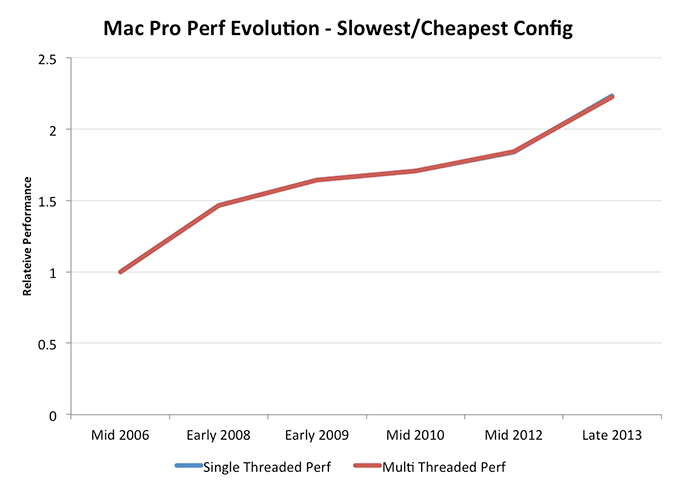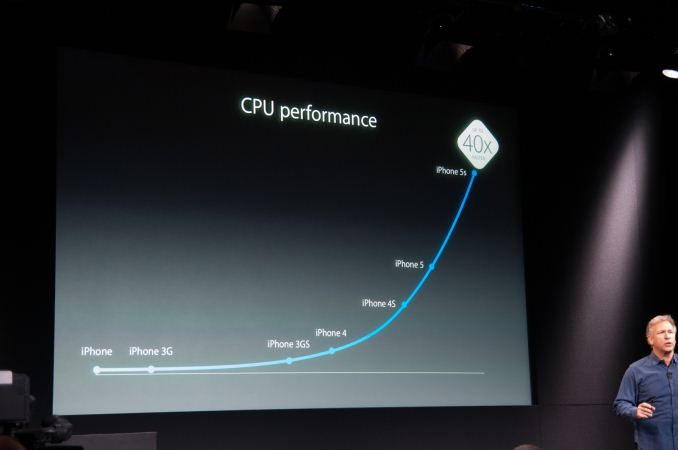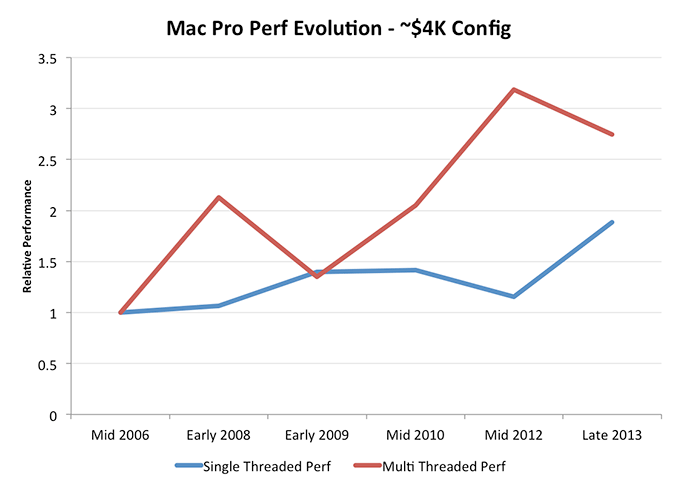The Mac Pro Review (Late 2013)
by Anand Lal Shimpi on December 31, 2013 3:18 PM ESTSetting Expectations: A Preview of What's to Come in Mobile
Sitting in the audience at the iPhone 5s launch I remember seeing this graph showing iPhone CPU performance increase since the first iPhone. Apple claimed a 41x increase in CPU performance if you compared the Cyclone cores in its A7 SoC to the ARM11 core in the first iPhone. What’s insane is just how short of a time period that comparison spans: 2007 - 2013.
I ran SunSpider on all of the iPhones in our 5s review to validate Apple’s numbers. I came out with roughly a 100x increase in performance, or something closer to half of that if you could run later versions of iOS (with Safari/js perf improvements). SunSpider is a very CPU and browser bound workload, but even if we turn to something a bit closer to real world usage like Browsermark 2.0 I measured a 5x increase in CPU performance over the past 6 years of iPhones.
I frequently refer to the progress we’ve seen in mobile as being hyper-moore’s-law. Until recently, the gains in mobile hadn’t yet approached a point where they were limited by process technology. Instead it’s variables like cost or time to market that govern how much performance was delivered each year. We’re at the beginnings of all of this changing, and it’ll eventually look a lot like what we’ve had in the desktop and mobile CPU space for years now.
When performance results from the new Mac Pro first hit, there seemed to be disappointment in how small some of the gains were. If you compare it to the progress in CPU performance Apple has demonstrated on the other side of the fence, you’re bound to be underwhelmed.
Having personally reviewed every CPU architecture that has gone into the Mac Pro since its launch, I had a rough idea of what to expect from each generation - so I decided to put it all in a chart.
I went back through all of my Conroe, Penryn, Nehalem, Westmere and Ivy Bridge data, looked at IPC improvement in video encoding/3D rendering workloads and used it to come up with the charts below. I made a table of every CPU offered in the Mac Pro, and scaled expected performance according to max single and multicore turbo.
Let’s first start by looking at what you can expect if you always buy the absolute cheapest Mac Pro. That means starting off with the Xeon 5130, moving to the E5462, then the W3520, W3530, W3565 and ending up with the E5-1620 v2 in today’s Mac Pro. I’ve put all of the choices in the table below:
| Mac Pro - Cheapest Configuration Upgrade Path | ||||||||||
| CPU | Chips | Cores per Chip | Total Cores / Threads | Clock Base/1CT/MaxCT | Launch Price | |||||
| Mid 2006 | Xeon 5130 | 2 | 2 | 4 / 4 | 2.0/2.0/2.0 GHz | $2199 | ||||
| Early 2008 | Xeon E5462 | 1 | 4 | 4 / 4 | 2.8/2.8/2.8 GHz | $2299 | ||||
| Early 2009 | Xeon W3520 | 1 | 4 | 4 / 8 | 2.66/2.93/2.8 GHz | $2499 | ||||
| Mid 2010 | Xeon W3530 | 1 | 4 | 4 / 8 | 2.8/3.06/2.93 GHz | $2499 | ||||
| Mid 2012 | Xeon W3565 | 1 | 4 | 4 / 8 | 3.2/3.46/3.33 GHz | $2499 | ||||
| Late 2013 | Xeon E5-1620 v2 | 1 | 4 | 4 / 8 | 3.7/3.9/3.7GHz | $2999 | ||||
If you always bought the cheapest Mac Pro CPU offering, this is what your performance curve in both single and multithreaded workloads would look like:

The first thing that stands out is both workloads follow roughly the same curve. The entry-level Mac Pro has always been a quad-core option, so you get no increased MT scaling (if you exclude the initial Nehalem bump from enabling Hyper Threading, which all subsequent Mac Pros have supported).
If you’ve always bought the slowest Mac Pro you’ll end up with a Mac Pro today that’s roughly 2.2x the performance of the very first Mac Pro. It’s a substantial increase in performance, but definitely not the sort of gains we’ve seen in mobile. For anyone who has been following the x86 CPU evolution over the past decade, this shouldn’t come as a surprise. There are huge power tradeoffs associated with aggressively scaling single threaded performance. Instead what you see at the core level is a handful of conservatively selected improvements. Intel requires that any new microarchitectural feature introduced has to increase performance by 2% for every 1% increase in power consumption. The result is the end of unabated increase in single threaded performance. The gains you see in the curve above are more or less as good as they get. I should point out that this obviously ignores the ~10% IPC gains offered by Haswell (since we don’t yet have a Haswell-EP). It’s also worth noting that Intel presently delivers the best single threaded performance in the industry. Compared to AMD alone you’re looking at somewhere around a 40% advantage, and ARM doesn’t yet offer anything that competes at these performance levels. It’s bound to be harder to deliver big gains when you’re at this performance level.
Back to the curve at hand, the increase in performance the 2013 Mac Pro offers is arguably one of the best upgrades over the life of the system - assuming you always opted for the entry level quad-core configuration.
What if you always did the opposite though and picked the highest-end CPU configuration? Same deal as before, I’ve documented the upgrade path in the table below:
| Mac Pro - Most Expensive Configuration Upgrade Path | ||||||||||
| CPU | Chips | Cores per Chip | Total Cores / Threads | Clock Base/1CT/MaxCT | Launch Price | |||||
| Mid 2006 | Xeon X5365 | 2 | 4 | 8 / 8 | 3.0/3.0/3.0 GHz | $3999 | ||||
| Early 2008 | Xeon X5482 | 2 | 4 | 8 / 8 | 3.2/3.2/3.2 GHz | $4399 | ||||
| Early 2009 | Xeon X5570 | 2 | 4 | 8 / 16 | 2.93/3.33/3.06 GHz | $5899 | ||||
| Mid 2010 | Xeon X5670 | 2 | 6 | 12 / 24 | 2.93/3.33/3.06 GHz | $6199 | ||||
| Mid 2012 | Xeon X5675 | 2 | 6 | 12 / 24 | 3.06/3.46/3.2 GHz | $6199 | ||||
| Late 2013 | Xeon E5-2697 v2 | 1 | 12 | 12 / 24 | 2.7/3.5/3.0 GHz | $6999 | ||||
Now things start to get interesting. For starters, single and multithreaded performance scaling is divergent. The high-end CPU option started as two quad-core CPUs but after three generations moved to a total of twelve cores. What this means is that after the early 2009 model you see a pretty significant increase in multithreaded performance for the fastest Mac Pro configuration. Scaling since then has been comparatively moderate as you’re looking at IPC and frequency improvements mostly with no change in core count.
The single threaded performance improvement, by comparison, is fairly mild. If you bought the most expensive Mac Pro configuration back in 2006 you had a 3GHz part. In the past 7 years peak single core turbo has only improved by 30% to 3.9GHz. Granted there are other efficiency gains that help push the overall improvement north of 50%, but that’s assuming you haven’t purchased anything since 2006. If you bought into the Mac Pro somewhere in the middle and opted for a high-end configuration, you definitely won’t see an earth shattering increase in single threaded CPU performance. Note that we’re only looking at one vector of overall performance here. We aren’t taking into account things like storage and GPU performance improvements (yet).
For the third configuration I wanted to pick something in the middle. The issue is that there is no middle config for entirety of the Mac Pro’s history. In some cases shooting for the middle meant you’d end up with 4 cores, while other times it meant 6, 8 or 12. We settled on trying to shoot for a $4000 configuration each time and never go above it. It turns out that if you always had a $4000 budget for a Mac Pro and tried to optimize for CPU performance you’d end up with a somewhat bizarre upgrade path. The path we took is listed in the table below:
| Mac Pro - Mid-Range Configuration Upgrade Path | ||||||||||
| CPU | Chips | Cores per Chip | Total Cores / Threads | Clock Base/1CT/MaxCT | Launch Price | |||||
| Mid 2006 | Xeon 5160 | 2 | 2 | 4 / 4 | 3.0/3.0/3.0 GHz | $3299 | ||||
| Early 2008 | Xeon E5472 | 2 | 4 | 8 / 8 | 3.0/3.0/3.0 GHz | $3599 | ||||
| Early 2009 | Xeon W3580 | 1 | 4 | 4 / 8 | 3.33/3.6/3.46 GHz | $3699 | ||||
| Mid 2010 | Xeon W3680 | 1 | 6 | 6 / 12 | 3.33/3.6/3.46 GHz | $3699 | ||||
| Mid 2012 | Xeon E5645 | 2 | 6 | 12 / 24 | 2.4/2.67/2.4 GHz | $3799 | ||||
| Late 2013 | Xeon E5-1650 v2 | 1 | 6 | 6 / 12 | 3.5/3.9/3.6 GHz | $3999 | ||||
Around $4000 the Mac Pro went from a quad-core system to eight-cores, back down to four cores, then up to six, then twelve and finally settling back at six cores this generation. What this means is a cycling between improving single and multithreaded performance over the course of the past 7 years:
Here’s where the comparison gets really interesting. If you spent $3799 on a Mac Pro last year, in order to see a multithreaded performance uplift on the CPU side you’d need to spend more this year. Single threaded performance on the other hand sees a big uptick compared to last year. The 2012 $4K config is the outlier however, if you have a budget fixed at $4000 then a 2013 Mac Pro will be quicker in all aspects compared to any previous generation Mac Pro at the same price point.
The bigger takeaway from this is the following: the very same limited gains in CPU performance will eventually come to ultra mobile devices as well. It’s only a matter of time before those CPU curves flatten out. What that does to the smartphone/tablet market is a discussion for another day.













267 Comments
View All Comments
Ppietra - Friday, January 3, 2014 - link
An object with black color only implies that it absorbs visible light. Thermal radiation is mostly infrared not visible light, so being black has no consequence since there is nothing emitting visible radiation internally. Externally the surface is very reflective so no problem there either - not that there would be one it wasn’t reflectivecosmotic - Tuesday, December 31, 2013 - link
It would be nice to see storage performance of the Mac Pro SSD against RAID on mechanical disks and SSD disks from a previous Mac Pro model.cosmotic - Tuesday, December 31, 2013 - link
Including IOPSacrown - Tuesday, December 31, 2013 - link
The early 2008 Mac Pro does not support hyperthreadimg as your charts indicate. Of course I could just be doing something wrong with mine...acrown - Tuesday, December 31, 2013 - link
Stupid onscreen keyboard. I meant hyperthreading of course.Anand Lal Shimpi - Tuesday, December 31, 2013 - link
Whoops, you're right! Fixed :)acrown - Tuesday, December 31, 2013 - link
Great article by the way. I'm so on the fence about whether to get one to replace my current Mac Pro.The read is tempting me more and more though...
ananduser - Tuesday, December 31, 2013 - link
It's actually simple, it's the best OSX workstation for seemingly only Apple software that actually makes full use of the GPU setup.If your workflow revolves exclusively around FCX, it is the only workstation you'll need. If you're an average consumer wanting a powerful OSX machine you'd better get a consumer oriented imac.
PS: No need for me to mention that if you'll need CUDA and Windows then it's a bad buy.
akdj - Wednesday, January 1, 2014 - link
I'd expect OpenCL to become more and more and MORE ubiquitous as time marches on and Moore's law in relation to CPU slows...and more computing can be taken care of via screaming fast GPUs. Again. Early adopters. But CUDA/Windows options are aplenty. Just more expensive and without twin GPUs. Without PCIe storage. And.....oh yeah, their Windows boxes. At least with the MP you can run Windows...and perhaps, as we saw Adobe so quickly do with HiDPI support post rMBP release (along with hundreds of other apps and software companies)---hopefully Windows 8.2/9.x realizes the more significant 'all around' gains utilizing OpenCL (nVidia too?) than the very, VERY select software titles that take advantage of CUDA....and when they do, it's primal in comparison to what OpenCL opens the doors for. Literally. Everythingmoppop - Wednesday, January 1, 2014 - link
Considering CUDA is a GPGPU API there's no door that OpenCL opens that CUDA can't do...in fact, you could say that CUDA opens more doors on an Nvidia GPU. Nvidia also supports OpenCL since it was among the parties to help expand the api spec, but make no mistake, their flagship is CUDA.Aside from shunning Nvidia to market-segments whose software will be at least CUDA-accelerated (if there's GPU accelaration at all), my main beef with the Mac Pro, however, is that there are artificial limits placed by the design. Namely 1 CPU socket and only 4 DIMM slots.
For VFX/3DCG pros, the reality is that GPU rendering simply isn't there yet. Your PRMan, Mental Ray, V-Ray (not real-time V-Ray), Arnold, and Mantra renderers are still very much in the CPU world. When professionals buy a machine they need it to work now, and not 5 years from now. While the Mac Pro certainly appeals to portions of the pro market-segment, it was a simply foolish reason to castrate the Mac Pro.